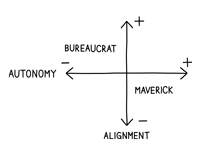|
Excerpted from "The Human Being's Guide to Business Growth."
Speeding Up Decision-Making
This is a good place to talk about increasing the speed of decision-making in your organization. The speed of your people’s decisions is not dependent on a quirk in their personalities. Ted doesn’t make decisions faster than Mary because she’s more cautious, and he’s more carefree. Their daily decisions rely on the interaction of two forces: autonomy and alignment.
Autonomy comes from the leadership team. We’re defining it as self-reliance, self-rule, or independence. It’s earned over time. The more your people are given the autonomy to make decisions without direction from above, the faster decisions will be made.
Alignment also comes from the leadership team. We’re defining it as positioned or arranged in line with the strategic vision of the company. It’s a communication issue. The more your people are aligned with the strategic vision of the company, the better their decisions will be.

When we bring up the Ted and Mary examples, the first thing most people think of is a Ted with high autonomy and low alignment. The prima donna who asks for forgiveness and not permission. We find him in sales, out shaking trees and making things happen. When we think of Mary, we put her in high alignment and low autonomy. The bureaucrat that knows what the strategic vision is, understands exactly what the playing field is, and hides in the middle of it, not wanting to make the wrong call.
The way to speed up decision-making is to move both Ted and Mary into the upper right quadrant. Mary will make more decisions, faster, when she feels that she has the autonomy to make those calls. She benefits the most from understanding her strengths and applying them to the tasks at hand. Ted will make better decisions with the same speed when he knows the playing field boundaries. He benefits the most from understanding the clear vision of where he needs to be and when he has stepped over the line.
They are rudimentary examples, but they illustrate the importance of a strong strategic vision for better decision-making. The fewer people who decide the vision, the stronger it is, and the clearer it is communicated, especially in mid-sized companies.
|